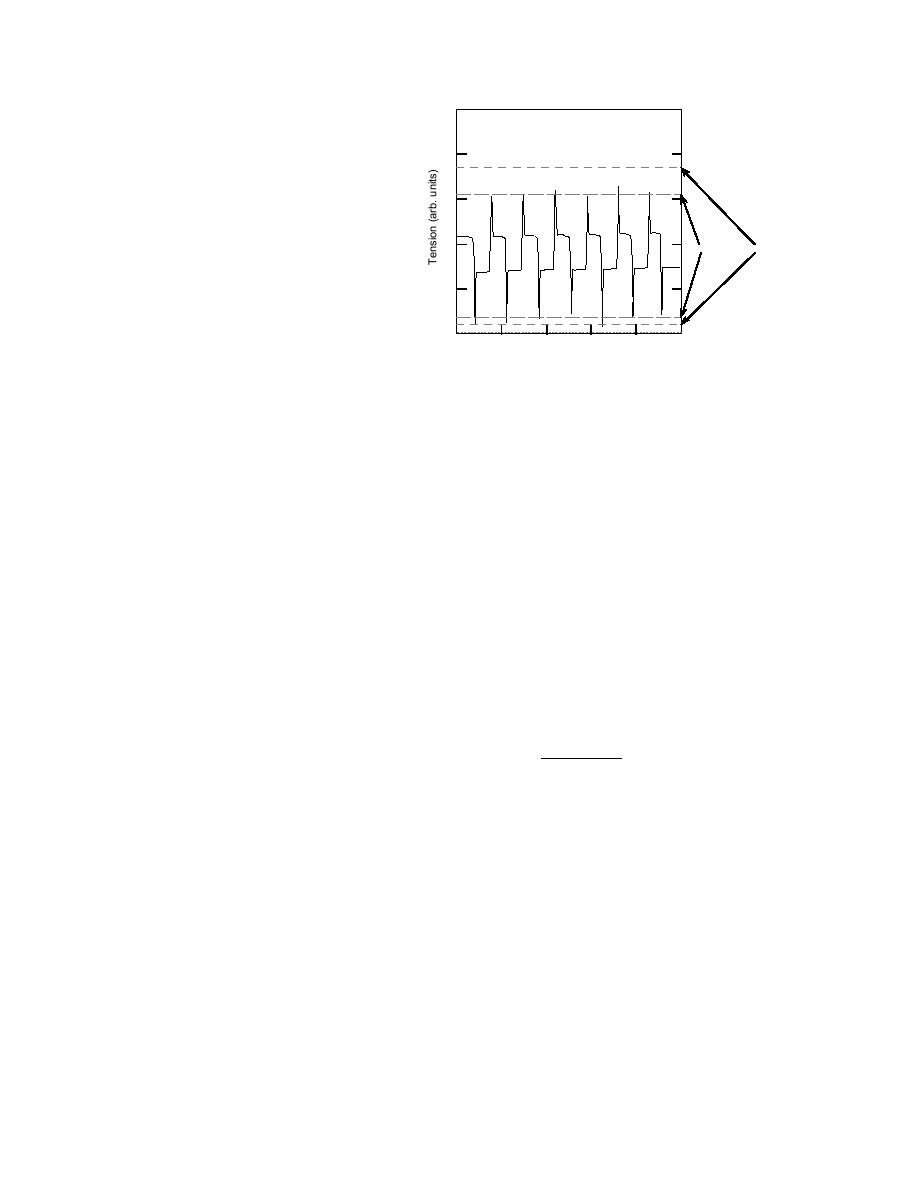
10
8
T2
6
Figure 11. Changes in tension of the stainless
steel foil belt when the ice cylinder direction of
4
V = 2 kV
V=0
rotation reverses (after Petrenko 1994a). Tem-
perature is 10C. Peaks correspond to static
2
friction. The two sets of dashed lines indicate the
T1
when 2-kV dc bias between ice and steel was
0
0
20
40
60
80
100
= 0 and ≈0.312 at V = 2 kV.
Time (s)
tween sliding, there was usually no pronounced differ-
of resistance to shear stress, or in other words results in
ence between static and dynamic friction, and the elec-
an increase of frictional force.
trical field affected friction in the manner shown in
The effect of an electrical field on the plasticity of
Figure 10. Once again, a strong field effect such as that
ice may also contribute to the observed effect of a field
shown in Figure 11 cannot be explained in terms of
on static friction (see Fig. 11). In addition to that mech-
electrostatic pressure.
anism, there is the possibility that the applied field
As working hypotheses accounting for the phenom-
changes the contact area between the ice and metal.
ena observed, I considered electrostatic pressure (see
The following grounds support this assumption: the ef-
eq 12), the effect of static electrical fields on the plastic
fect of an electrical field on static friction was ob-
deformation of ice and expansion of the contact area
served only when the temperature was high enough
caused by electrical fields.
that a quasi-liquid film, characterized by low viscosity
Electrostatic fields externally applied to the inter-
and a large self-diffusion coefficient as compared to
face between ice and a dielectric slider are able to sig-
ice, existed at the ice surface. When a strong electrical
nificantly alter normal pressure and, consequently, the
field is present in the voids between ice and metal, ice
friction force (eq 12). Perhaps a more important and
is attracted into these regions by the electrostatic pres-
interesting fact is that such electrostatic attraction be-
sure and tends to fill them. Since the static dielectric
permittivity of ice is quite large (εs ≈ 100), the driving
tween ice and a slider always occurs by itself owing to
the frictional electrification. Under certain conditions,
force of electrostatic pressure is also quite large
such electrification can contribute to the formation of
ε 0 (εs - 1)E 2
the friction force.
P=
.
(13)
The effect of electrical fields on plastic deformation
2
of thin ice monocrystals (Petrenko and Schulson 1993)
was used to explain the action of an external electrical
A mass transfer at high temperatures can efficiently
field on the dynamic friction of metal sliders against
occur along the quasi-liquid film, filling air gaps be-
ice. It appears that an application of relatively small dc
tween the ice and the metal slider and increasing the
electrical biases, on the order of 50 V, to an ice/metal
ice adhesion.
interface reduces by nearly an order of magnitude the
The above experimental facts and discussion show
plasticity of a layer of ice of 50100 m thickness ad-
the importance of electrical effects on ice friction.
jacent to the metal. This in turn is caused by the extrac-
Physical mechanisms of the phenomena are not deter-
tion of the major charge carriers (Bjerrum defects)
mined yet. We have considered here only a few obvi-
from the region near the electrode by the electrical
ous mechanisms that are known to be applicable under
field (Petrenko and Schulson 1992). Depletion of Bjer-
similar experimental conditions and can be easily esti-
rum defects from the subsurface layer of ice alters the
mated. Other mechanisms, such as electrolytic effects
caused at the metal/ice interface, the role of thin local
conditions of dislocation motion, which results in the
liquid patches, modification of the mechanical properties
reduction of plasticity. When ice slides, there is a plas-
tic shear deformation in the contact zones between the
of ice surface by multiple local meltrefreeze, etc.,
ice and slider. Therefore, a reduction in the plasticity
should also be analyzed. This is an extensive field for
of ice when a voltage V is applied results in an increase
future study.
9




 Previous Page
Previous Page
